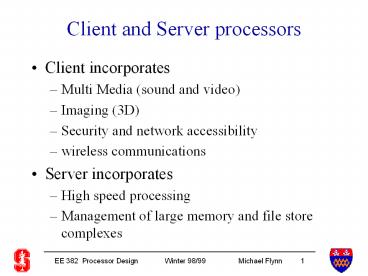Client and Server processors PowerPoint PPT Presentation
1 / 28
Title: Client and Server processors
1
Client and Server processors
- Client incorporates
- Multi Media (sound and video)
- Imaging (3D)
- Security and network accessibility
- wireless communications
- Server incorporates
- High speed processing
- Management of large memory and file store
complexes
2
Client processors
- Modern processors are being enhanced to support
multimedia, security, etc. - Most of the recent interesting processor
developments have been in client processors - largest market, not dominated by clock speed, and
more amenable to low power implement. - system on a die includes dsp arithmetic and as
much structured memory as possible.
3
Multi Media
- Includes video, audio, 3 D graphic imaging, as
well as subsidiary functions such as music
(composition and rendering), voice recognition,
handwriting rec., animation - Closely coupled to the display / presentation
technology (raster line or pixel density, audio
speaker fidelity / range)
4
Still Images/ Video/ Audio
- The problem is compression and meeting real time
constraints - a B/W still image, 512x512 pixels, represents
about 1/4 MB (8b/pixel) color (3B/pixel) almost
1MB use 1 MB as a typical image - video requires 30 frames/sec 30MB/sec 1 hour is
108GB - voice requires 44k samples/sec 3B/samples/sec 2
or more channels about 1/4 MB/sec.
5
Still Images
- Lossless vs. Lossy compression
- a simple bounded Huffman code gives 31 lossless
compression - JPEG is standard
- offers (say) 251 lossy compression
- tradeoffs image quality - file size -
computational complexity
6
JPEG
- Image is partitioned into 8x8 pixel blocks
- transform into frequency domain by DCT (the high
freq components are at the high index values of
the resultant 8x8 matrix and often 0. - Quantize (the lossy step) map values to few
numbers - Zig zag access, to access low freq components
(non 0) values first. - Huffman (run length) encode values
7
Discrete cosine transform (DCT)
- Map X (spatial domain) to Y (freq. domain)
- more compact representation, use 8x8 pixel blk
- yu,v (4C(u) C(v)/n2) SjSkx(u,v) cos(2j1)
up/2n cos(2k1) vp/2n - C(w) 1for w1,2 or C(w) 1/sqrt2 for
w0 - better than discrete Fourier transform, but
needs more computation
8
DCT basis functions
9
Block diagram of JPEG encoder
10
Video
- Popular standards
- H263 (video conferencing)
- MPEG 1 (VHS quality)
- MPEG 2 (Broadcast quality)
- MPEG 4 (uses VOPs to achieve high quality with
good compression). More complex, an emerging
standard
11
Typical compression
- Image size, quality and delay are factors
- Lossless 31
- JPEG 251
- MPEG1 1001 uses 352x288 CIF 1-2 sec
- H 263 maybe 3001 QCIF 176x144 1/4sec
- MPEG2 4xCIF uses lower Q longer delay
12
MPEG frames
- Three types of frames
- I intra-picture, like lossy JPEG
- P predicted picture, motion prediction based on
earlier I motion vector plus error terms, as
error terms are small quantizing gives good
compression - B bidirectional pictures, motion prediction based
on past and future I or P - result is GOP, e.g. IPBBPBBPBBPBBPBBI
13
I frames
- In MPEG typically use 1 I per 15 frames
- In H263 maybe 1 I per 300 frames
- I frames take (maybe) 4x bits to represent than a
P or B frame.
14
MPEG block diagram
15
P frames
- Motion prediction is computationally intensive
based on macro blocks 2x2 blocks - 16x16 of luminance, 1 8x8 Cr, 1 8x8 Cb, color is
interleaved (called 420)
16
Motion estimation process
17
Forward motion compensation
18
Motion estimation
- Computation intensive
- Compute SAD for all neighboring macro block
combinations (index by 1 pixel). - S xi,j-yi,k across all macro blocks
- Find location that minimizes SAD
19
Bidirectional motion compensation
20
Block diagram of MPEG encoder
21
Instructions /pixel
- JPEG about 320 to compress280 to decode
- MPEG1 about 1100 to compress about 80 to decode.
- Note problem in motion estimation need 352
x 288 x 1100 x 30 instr /sec 3.3 GIPS for
MPEG1 to compress. - MPEG2 uses bigger frames better motion
estimation and color maybe20 GIPS
22
Video memory
- Even if we have enough arithmetic BW, memory
(cache) access is a problem. A single CIF frame
has 200 - 400 kB and wont fit into a L2 caches
less than (say) 1 or 2 MB. Worse is the behavior
of the L1 D cache. There are NO hits after a line
is used. - Solution prefetch and stride prediction caches
at L1.
23
Audio
- Frequency range 20-20k Hz _at_ 2x sampling
- Sample rates
- 8k telephone
- 22k personal computers
- 32k digital audio and TV
- 44k CDs
- 48k HDTV, DAT
24
Audio
- Dynamic range 0 to 120db about 20 bits of
exponent - Phasing 2 or more channels to locate source
- Clipping ear tolerates about 200ms delay, after
300ms becomes annoying. - Bit rates 44k x 20 x 2 1.7 Mbps or (PCs) 22k
x 16 352 kbps
25
Audio
- Can do better by compression use ADPCM and send
the difference between adjacent pulses G722
standard 16k with ADPCM to fit into 64kbps. - G728 uses linear predictive coder achieves
16kbps. Models voice as a linear filter matches
sample with codebook, send index into receivers
codebook
26
MPEG audio
- Compresses digital audio signals (PCM)
- Uses 32 sub band filters (512 taps), samples
shifted 32 at a time. Computation is s(i)
Snx(t- n) Hi(n) over n 512 per sample Hi(n)
is the impulse response for the ith filter. Thus
we have 512 multiply-accumulates per sample.
About 22Mops/sec
27
MPEG Audio
- Sample rates 32, 44, 48 kHz
- Mono, stereo or joint stereo
- Bit rates 64kbps to 128kbps, several layers and
coder complexity to get better bit rates and/or
better quality. - Computationally requires probably 5 - 100 million
multiply-adds per second (16b).
28
MPEG audio encoder

